Editorial
, Volume: 6( 3)Incorporation of Vitreoscilla hemoglobin gene mitigates biofilm formation in Bacillus Subtilis DK1042
Riddhi Vyas
The Maharaja Sayaji Rao University of Baroda, India
Abstract
Editorial
Biofilm formation is often considered as a stress combating strategy adopted by bacteria in response to a variety of cellular and environmental signals. Impaired respiration triggers biofilm formation in B. subtilis. Vitreoscilla hemoglobin (VHb) is known to supply oxygen to respiratory chain and hence improves aerobic growth and bioproduct synthesis of a variety of bacteria including Bacillus spp. Although VHb improves respiration, very little efforts have been made in elucidating its effect on biofilm formation. B. subtilis DK1042 was genetically modified to develop two integrants NRM1113 and NRM1114 containing vgb-gfp operon under 2 and 5 copies of P43 promoters, respectively, at an amyE locus by double-crossover events. Effect of VHb on biofilm formation by integrants and wild-type (WT) was assessed on both solid and pellicle biofilm in lysogeny broth (LB) and LB supplemented with 1% glycerol and 0.1mM manganese (LBGM). Here, we report that genomic integration of vgb gene in B. subtilis DK1042 mitigates biofilm formation and associated sporulation under different conditions. It also decreases the sporulation associated brown pigment production in minimal medium in shake flask cultures. These findings suggest that VHb mediated prolonged vegetative state may augment the production of desired bioproducts by host Bacillus spp. Reduced biofilm forming phenotype in LBGM medium and hyperosmotic conditions indicates that VHb has a profound impact on entire regulatory network governing biofilm formation. Use of VHb harboring Bacillus biofertilizers will have a tremendous advantage during their sessile lifestyle in rhizosphere that may enhance their performance as Plant Growth Promoting Rhizobacteria (PGPR) and Rhizoremedial agents.
Expression studies of genes encoding structural components of biofilms revealed ~ 70% down-regulation of bslA gene in NRM1113 on both LB and LBGM which is correlated with reduced wrinkling in NRM1113. Moreover, NRM1113 showed increased colony expansion compared to WT in LB, LBGM and high osmolarity conditions. VHb expression alters various processes in different host cells, our study represents that VHb modulates biofilm formation, sporulation and pulcherriminic acid formation in B. subtilis DK1042. A chimeric construct consisting of the double CaMV35S promoter fused to the Myc-vhb gene encoding Vitreoscilla (bacterial) hemoglobin (VHb) was introduced into Arabidopsis thaliana and transgenic plants were cultured under various growth and stress conditions with the aim of studying the generality phenomena. Molecular analysis indicated that the exogenous vhb was stably integrated into the Arabidopsis genome and successfully expressed. Constitutive vhb expression improved the germination rate of transgenic seeds. Under submergence conditions, in vitro and in vivo bioassays revealed that the vhb expression protected transgenic plants against prolonged waterlogging. Leaf discs from the transgenic plants maintained in standard growth conditions reveal increased tolerance to nitrosative stress induced by sodium nitroprusside (SNP) treatment. Significant differences in chlorophyll a, b, total protein content and conductivity were observed among the transgenic, wild type (WT) and blank transformation (CK) plants. No significant differences were observed between the tested VHb, WT and CK lines in the presence of oxidative stresses by paraquat treatment. VHb expression also affected the levels of some Arabidopsis endogenesis genes that are involved in oxygen metabolism and antioxidants biosynthesis; up-regulating their expression at transcriptional level. LC?MS revealed that VHb expression shifted plant secondary metabolism, which may reflect the availability of extra metabolite production for possible enhanced protection ability. VHb transgenic plants were more tolerant to photo-oxidative damage due to the increased antioxidants, such as ascorbate. These results suggested that vhb gene might have the potential use in molecular breeding for the improvement of stress resistance and fine chemicals production in plants. In this study, we established a system to study the interaction of B. subtilis with tomato plants. We demonstrate that B. subtilis forms robust biofilms on tomato plant roots in a manner that depends on matrix genes. We further show that biofilm formation can be elicited by an exudate from tomato plant roots and that this response is principally dependent on one of the four kinases, KinD. KinD is an integral membrane protein that exhibits an extracellular domain of similarity to the CACHE domain of small molecule sensing proteins (Wu et al., 2008; Zhang and Hendrickson, 2010). Biofilm formation on roots and the response to root exudates are blocked in a mutant of the KinD CACHE domain, which we infer is responsible for sensing one or more signals released by plant roots. Finally, we identify a group of small molecules that are abundantly present in tomato root exudates. Among them was L-malic acid, which was also identified previously as being abundantly secreted by plant roots .

